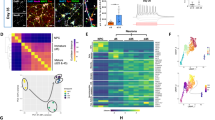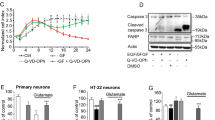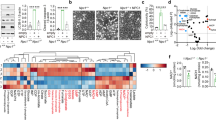Abstract
Deficiency of the apoptosome component Apaf1 leads to accumulation of supernumerary brain cells in mouse embryos. We observed that neural precursor cells (NPCs) in Apaf1−/− embryos escape programmed cell death, proliferate and retain their potential to differentiate. To evaluate the circumstances of Apaf1−/− NPC survival and investigate their fate under neurodegenerative conditions, we established cell lines of embryonic origin (ETNA). We found that Apaf1−/− NPCs resist common apoptotic stimuli and neurodegenerative inducers such as amyloid-β peptide (typical of Alzheimer's disease) and mutant G93A superoxide dismutase 1 (typical of familial amyotrophic lateral sclerosis). Similar results were obtained in Apaf1−/− primary cells. When death is prevented by Apaf1 deficiency, cytochrome c is released from mitochondria and rapidly degraded by the proteasome, but mitochondria remain intact. Under these conditions, neither activation by cleavage of initiator caspases nor release of alternative apoptotic inducers from mitochondria takes place. In addition, NPCs can still differentiate, as revealed by neurite outgrowth and expression of differentiation markers. Our findings imply that the mitochondrion/apoptosome pathway is the main route of proneural and neural cells to death and that its inhibition prevents them from dismantling in neurodegenerative conditions. Indeed, the ETNA cell model is ideally suited for exploring the potential of novel cell therapies for the treatment of human neurodegenerations.
Similar content being viewed by others
Log in or create a free account to read this content
Gain free access to this article, as well as selected content from this journal and more on nature.com
or
Abbreviations
- NPCs:
-
neural precursor cells
- Apaf:
-
apoptotic proteases-activating factor
- ETNA:
-
embryonic telencephalic naïve Apaf1
- Casp:
-
caspase
- Aβ:
-
amyloid-β1–42 peptide
- SOD1:
-
superoxide dismutase 1
- AD:
-
Alzheimer's disease
- fALS:
-
familial amyotrophic lateral sclerosis
- CNS:
-
central nervous system
- wt:
-
wild type
- e:
-
embryonic day
- ChAT:
-
choline acetyltransferase
- βIII-tubulin:
-
class III β-tubulin
- STS:
-
staurosporine
- Act D:
-
actinomycin D
- PARP:
-
poly ADP ribose polymerase
- fmk:
-
fluoromethylketone
- AIF:
-
apoptosis-inducing factor
- EndoG:
-
endonuclease G
- Δψm:
-
mitochondrial transmembrane potential
- TMRE:
-
tetramethylrhodamine ethyl ester
- EM:
-
electron microscopy
- GFP:
-
green fluorescent protein
- NGF:
-
nerve growth factor
- BrdU:
-
bromodeoxy-uridine
References
Adams JM and Cory S (2002) Apoptosomes: engines for caspase activation. Curr. Opin. Cell. Biol. 14: 715–720
Zou H, Henzel WJ, Liu X, Lutschg A and Wang X (1997) Apaf-1, a human protein homologous to C. elegans CED-4, participates in cytochrome c-dependent activation of caspase-3. Cell 90: 405–413
Cecconi F, Alvarez-Bolado G, Meyer BI, Roth KA and Gruss P (1998) Apaf1 (CED-4 homolog) regulates programmed cell death in mammalian development. Cell 94: 727–737
Yoshida H, Kong YY, Yoshida R, Elia AJ, Hakem A, Hakem R, Penninger JM and Mak TW (1998) Apaf1 is required for mitochondrial pathways of apoptosis and brain development. Cell 94: 739–750
Honarpour N, Du C, Richardson JA, Hammer RE, Wang X and Herz J (2000) Adult Apaf-1-deficient mice exhibit male infertility. Dev. Biol. 218: 248–258
Kuan CY, Roth KA, Flavell RA and Rakic P (2000) Mechanisms of programmed cell death in the developing brain. Trends Neurosci. 23: 291–297
Yuan J and Yankner BA (2000) Apoptosis in the nervous system. Nature 407: 802–809
Krammer PH (2000) CD95's deadly mission in the immune system. Nature 407: 789–795
Marsden VS, O'Connor L, O'Reilly LA, Silke J, Metcalf D, Ekert PG, Huang DC, Cecconi F, Kuida K, Tomaselli KJ, Roy S, Nicholson DW, Vaux DL, Bouillet P, Adams JM and Strasser A (2002) Apoptosis initiated by Bcl-2-regulated caspase activation independently of the cytochrome c/Apaf-1/caspase-9 apoptosome. Nature 419: 634–637
Guegan C and Przedborski S (2003) Programmed cell death in amyotrophic lateral sclerosis. J. Clin. Invest. 111: 153–161
Zimmerman L, Parr B, Lendahl U, Cunningham M, McKay R, Gavin B, Mann J, Vassileva G and McMahon A (1994) Independent regulatory elements in the nestin gene direct transgene expression to neural stem cells or muscle precursors. Neuron 12: 11–24
Cattaneo E and Conti L (1998) Generation and characterization of embryonic striatal conditionally immortalized ST14A cells. J. Neurosci. Res. 53: 223–234
Ehrlich ME, Conti L, Toselli M, Taglietti L, Fiorillo E, Taglietti V, Ivkovic S, Guinea B, Tranberg A, Sipione S, Rigamonti D and Cattaneo E (2001) ST14A cells have properties of a medium-size spiny neuron. Exp. Neurol. 167: 215–226
Cleveland DW and Rothstein JD (2001) From Charcot to Lou Gehrig: deciphering selective motor neuron death in ALS. Nat. Rev. Neurosci. 2: 806–819
Lassus P, Opitz-Araya X and Lazebnik Y (2002) Requirement for caspase-2 in stress-induced apoptosis before mitochondrial permeabilization. Science 297: 1352–1354
Zhang X, Graham SH, Kochanek PM, Marion DW, Nathaniel PD, Watkins SC and Clark RS (2003) Caspase-8 expression and proteolysis in human brain after severe head injury. FASEB J. 17: 1367–1369
Sperandio S, de Belle I and Bredesen DE (2000) An alternative, nonapoptotic form of programmed cell death. Proc. Natl. Acad. Sci. USA 97: 14376–14381
Susin SA, Lorenzo HK, Zamzami N, Marzo I, Snow BE, Brothers GM, Mangion J, Jacotot E, Costantini P, Loeffler M, Larochette N, Goodlett DR, Aebersold R, Siderovski DP, Penninger JM and Kroemer G (1999) Molecular characterization of mitochondrial apoptosis-inducing factor. Nature 397: 441–446
Cande C, Cecconi F, Dessen P and Kroemer G (2002) Apoptosis-inducing factor (AIF): key to the conserved caspase-independent pathways of cell death? J. Cell. Sci. 115: 4727–4734
Cregan SP, Fortin A, MacLaurin JG, Callaghan SM, Cecconi F, Yu SW, Dawson TM, Dawson VL, Park DS, Kroemer G and Slack RS (2002) Apoptosis-inducing factor is involved in the regulation of caspase-independent neuronal cell death. J. Cell. Biol. 158: 507–517
Arnoult D, Gaume B, Karbowski M, Sharpe JC, Cecconi F and Youle RJ (2003) Mitochondrial release of AIF and EndoG requires caspase activation downstream of Bax/Bak-mediated permeabilization. EMBO J. 22: 4385–4399
Arnoult D, Parone P, Martinou JC, Antonsson B, Estaquier J and Ameisen JC (2002) Mitochondrial release of apoptosis-inducing factor occurs downstream of cytochrome c release in response to several proapoptotic stimuli. J. Cell. Biol. 159: 923–929
van Loo G, Schotte P, van Gurp M, Demol H, Hoorelbeke B, Gevaert K, Rodriguez I, Ruiz-Carrillo A, Vandekerckhove J, Declercq W, Beyaert R and Vandenabeele P (2001) Endonuclease G: a mitochondrial protein released in apoptosis and involved in caspase-independent DNA degradation. Cell Death Differ. 8: 1136–1142
Waterhouse NJ, Goldstein JC, von Ahsen O, Schuler M, Newmeyer DD and Green DR (2001) Cytochrome c maintains mitochondrial transmembrane potential and ATP generation after outer mitochondrial membrane permeabilization during the apoptotic process. J. Cell. Biol. 153: 319–328
Ricci JE, Gottlieb RA and Green DR (2003) Caspase-mediated loss of mitochondrial function and generation of reactive oxygen species during apoptosis. J. Cell. Biol. 160: 65–75
Ferraro E, Corvaro M and Cecconi F (2003) Physiological and pathological roles of Apaf1 and the apoptosome. J. Cell. Mol. Med. 7: 21–34
Honarpour N, Gilbert SL, Lahn BT, Wang X and Herz J (2001) Apaf-1 deficiency and neural tube closure defects are found in fog mice. Proc. Natl. Acad. Sci. USA 98: 9683–9687
Troy CM, Rabacchi SA, Friedman WJ, Frappier TF, Brown K and Shelanski ML (2000) Caspase-2 mediates neuronal cell death induced by beta-amyloid. J. Neurosci. 20: 1386–1392
Nakagawa T, Zhu H, Morishima N, Li E, Xu J, Yankner BA and Yuan J (2000) Caspase-12 mediates endoplasmic-reticulum-specific apoptosis and cytotoxicity by amyloid-beta. Nature 403: 98–103
Martinou I, Desagher S, Eskes R, Antonsson B, Andre E, Fakan S and Martinou JC (1999) The release of cytochrome c from mitochondria during apoptosis of NGF-deprived sympathetic neurons is a reversible event. J. Cell. Biol. 144: 883–889
Deshmukh M, Kuida K and Johnson Jr EM (2000) Caspase inhibition extends the commitment to neuronal death beyond cytochrome c release to the point of mitochondrial depolarization. J. Cell. Biol. 150: 131–143
Chang LK, Schmidt RE and Johnson Jr EM (2003) Alternating metabolic pathways in NGF-deprived sympathetic neurons affect caspase-independent death. J. Cell. Biol. 162: 245–256
Friedlander RM (2003) Apoptosis and caspases in neurodegenerative diseases. N. Engl. J. Med. 348: 1365–1375
Troy CM and Salvesen GS (2002) Caspases on the brain. J. Neurosci. Res. 69: 145–150
Inoue H, Tsukita K, Iwasato T, Suzuki Y, Tomioka M, Tateno M, Nagao M, Kawata A, Saido TC, Miura M, Misawa H, Itohara S and Takahashi R (2003) The crucial role of caspase-9 in the disease progression of a transgenic ALS mouse model. EMBO J. 22: 6665–6674
Storch A and Schwarz J (2002) Neural stem cells and neurodegeneration. Curr. Opin. Investig. Drugs 3: 774–781
Isacson O, Bjorklund LM and Schumacher JM (2003) Toward full restoration of synaptic and terminal function of the dopaminergic system in Parkinson's disease by stem cells. Ann. Neurol. 53 (Suppl 3): S135–S146; discussion S146-S138
Mattson MP (2000) Emerging neuroprotective strategies for Alzheimer's disease: dietary restriction, telomerase activation, and stem cell therapy. Exp. Gerontol. 35: 489–502
Carri MT, Ferri A, Battistoni A, Famhy L, Gabbianelli R, Poccia F and Rotilio G (1997) Expression of a Cu,Zn superoxide dismutase typical of familial amyotrophic lateral sclerosis induces mitochondrial alteration and increase of cytosolic Ca2+ concentration in transfected neuroblastoma SH-SY5Y cells. FEBS Lett. 414: 365–368
Ding H, Schwarz DS, Keene A, Affar el B, Fenton L, Xia X, Shi Y, Zamore PD and Xu Z (2003) Selective silencing by RNAi of a dominant allele that causes amyotrophic lateral sclerosis. Aging Cell 2: 209–217
Salminen M, Meyer BI, Bober E and Gruss P (2000) Netrin 1 is required for semicircular canal formation in the mouse inner ear. Development 127: 13–22
Stoykova A and Gruss P (1994) Roles of Pax-genes in developing and adult brain as suggested by expression patterns. J. Neurosci. 14: 1395–1412
Casciati A, Ferri A, Cozzolino M, Celsi F, Nencini M, Rotilio G and Carri MT (2002) Oxidative modulation of nuclear factor-kappaB in human cells expressing mutant fALS-typical superoxide dismutases. J. Neurochem. 83: 1019–1029
Acknowledgements
We thank Tilmann Achsel, Claudia Bagni, Daniela Barilá, Stefano Bertuzzi, Fulvio Celsi, Carlo Rodolfo and Rainer Herken for helpful discussion. We are grateful to Silke Eckert, Natalie Obermayer, Fulvio Florenzano and Elke Heyder for technical assistance, Johan Lundqvist and Urban Lendhal for RNA probes, Lorraine O’Reilly and Andreas Strasser for anti-Casp2 and anti-Apaf1 antibodies. We are indebted to Peter Gruss, Barbara I Meyer, Kamal Chowdhury and Anastassia Stoykova for the generation of the Apaf1−/− mice. This work was supported by Telethon (Grant TCP99038 to FC and GGP030066 to MTC), MIUR (Grant RBAU01FZMZ), Compagnia di San Paolo, and Min. Salute (PF 2002-04).
Author information
Authors and Affiliations
Corresponding author
Additional information
Edited by JC Martinou
Rights and permissions
About this article
Cite this article
Cozzolino, M., Ferraro, E., Ferri, A. et al. Apoptosome inactivation rescues proneural and neural cells from neurodegeneration. Cell Death Differ 11, 1179–1191 (2004). https://doi.org/10.1038/sj.cdd.4401476
Received:
Revised:
Accepted:
Published:
Issue date:
DOI: https://doi.org/10.1038/sj.cdd.4401476
Keywords
This article is cited by
-
Transcriptomic analysis of glutamate-induced HT22 neurotoxicity as a model for screening anti-Alzheimer’s drugs
Scientific Reports (2023)
-
Reversible induction of mitophagy by an optogenetic bimodular system
Nature Communications (2019)
-
AMBRA1 is able to induce mitophagy via LC3 binding, regardless of PARKIN and p62/SQSTM1
Cell Death & Differentiation (2015)
-
Apaf1-deficient cortical neurons exhibit defects in axonal outgrowth
Cellular and Molecular Life Sciences (2015)
-
The DNA repair complex Ku70/86 modulates Apaf1 expression upon DNA damage
Cell Death & Differentiation (2011)



